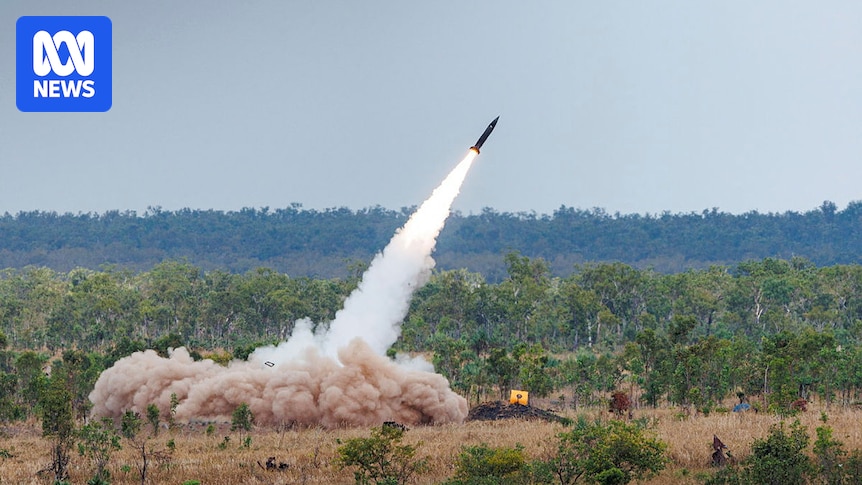The Australian Army has test fired its newest long-range missile for the first time, launching the weapon from a remote army training base in the Northern Territory.
The Precision Strike Missile (PrSM), which can hit distant targets with minimal warning and high accuracy, was fired from the Mount Bundey Training Area, south-east of Darwin, on Friday.
It hit its target over 300 kilometres away in four minutes and three seconds, reaching speeds of roughly 4,050 kilometres per hour — more than three times the speed of sound.
The firing missile was captured on video and broadcast at the site. (ABC News: Roxanne Fitzgerald)
Fired from US-made High Mobility Artillery Rocket Systems (HIMARS), the PrSM can strike targets at distances of up to 500 kilometres with precision — a significant leap from the Australian Army’s previous long-range strike range of just 30 kilometres.
At a press conference at Mount Bundey on Friday, Defence Industry Minister Pat Conroy said the new weapon marked the day the “Australian Army enters the missile age”.
“This is all about extending deterrence in the Indo-Pacific, all about signalling to any potential adversary that pain can be inflicted — all about deterring war through strength,” he said.
Pat Conroy attended the event. (ABC News: Roxanne Fitzgerald)
Developed for the United States Army, the PrSM was sent to Australia last month as part of a $310 million deal with the US.
The deal locks in Australian access to munitions, technological advancements and the option for future domestic manufacturing and maintenance.
Talisman Sabre is the largest annual bilateral military exercise between Australia and the United States. (ABC News: roxanne Fitzgerald)
The missile launch was conducted as part of Exercise Talisman Sabre, a joint military exercise involving more than 40,000 military personnel from 19 nations, including the US.
This year marks the largest iteration of the exercise since it began in 2005 as a way to practice maritime operations, air combat and live-fire exercises with international partners.
Charlie Vera is one of the soldiers taking part in Exercise Talisman Sabre. (ABC News: Roxanne Fitzgerald)
On Friday, the Secretary of the United States Army, Dan Driscoll, was more forthright in his assessment of where the message of deterrence was aimed at.
“President Trump, [the United States Secretary of Defence] Pete Hegseth and the rest of the Pentagon team have been very clear that our pacing threat is China,” he said.
Mount Bundey is more than an hour’s drive from Darwin. (ABC News: Roxanne Fitzgerald)
While the US Army’s chief of staff, General Randy George, did not respond directly to questions about an imminent threat, or whether there were enhanced capabilities in China, he said keeping up with technological advancements was “what keeps us up at night”.
“What we are trying to do is to transform as rapidly as possible,” he said.
Randy George says keeping up with technological advancements is crucial. (ABC News: Roxanne Fitzgerald)
Alex Miller, the US Army’s chief technology officer, said the PrSM’s high speed halved the amount of warning time given to a potential enemy.
He also said while the missile’s explosion would not “level a city”, its precision, driven by advanced navigation, was what made it lethal.
“When you think about having six to seven minutes rather than 15 to 20 minutes, that’s a lot less time for [a target] to pack up and roll out if they learn that they are being shot at,” he said.
Alex Miller says the missile’s precision is its greatest strength. (ABC News: Roxanne Fitzgerald)
In a statement from Mr Conroy’s office, a spokesperson said future upgrades to the PrSM could include an extended strike range of over 1,000 kilometres, improved sensors and novel warheads.
